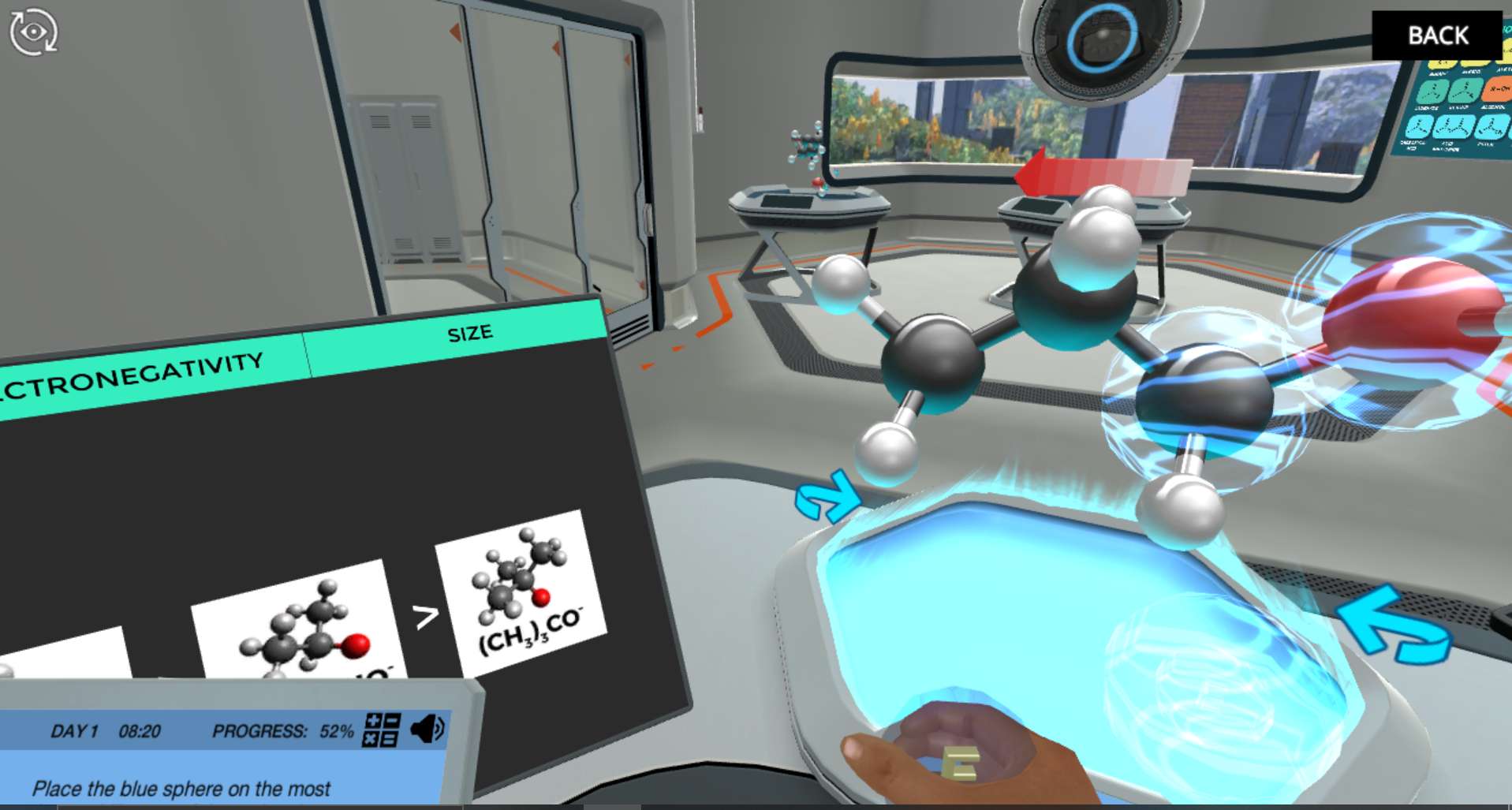Heading 1
Heading 2
Heading 3
Heading 4
Heading 5
Heading 6
Lorem ipsum dolor sit amet, consectetur adipiscing elit, sed do eiusmod tempor incididunt ut labore et dolore magna aliqua. Ut enim ad minim veniam, quis nostrud exercitation ullamco laboris nisi ut aliquip ex ea commodo consequat. Duis aute irure dolor in reprehenderit in voluptate velit esse cillum dolore eu fugiat nulla pariatur.
Block quote
Ordered list
- Item 1
- Item 2
- Item 3
Unordered list
- Item A
- Item B
- Item C
Bold text
Emphasis
Superscript
Subscript
About This Simulation
Determine the outcome of a chemical reaction between two organic compounds by mastering the fundamental rules of reactions in organic chemistry.
Learning Objectives
- Explain the concept of electronegativity and how the distribution of electrons across a molecule determines its reactivity
- Describe what a nucleophile, electrophile and leaving group are, and identify them
- Describe an organic chemical reaction and its mechanism using the correct terminology and notations (lonepairs, curly arrows, reactants, reagents, products, catalysts, intermediates, transition states)
- Draw reaction mechanisms using the correct notations
- Explain the differences between the three fundamental types of reactions: Addition, elimination and substitution
- Describe the typical reactivity of the main functional groups
About This Simulation
Lab Techniques
Related Standards
- HS-PS1-2
- HS-PS1-4
- Unit 4. Chemical Reactions
- 10.1 Fundamentals of organic chemistry
- 10.2 Functional group chemistry
- 20.1 Types of organic reactions
Learn More About This Simulation
Did you know that as you’re reading this text, you are interacting with at least one organic compound? Organic compounds are everywhere, and the field dedicated to exploring their structure, properties and reactions is called organic chemistry. In this simulation, you will explore the core principles of organic chemistry reactions to understand the fundamentals of reactivity.
How do electrons determine the reactivity of molecules?
Bonds: organic compounds are made of the number of atoms connected by chemical bonds. In your first mission, you will find the connection between electronegativity, polarity, and electron density. You will see how these concepts determine the reactivity of the molecule via the electron distribution in the molecule.
How do organic compounds react?
You may already know by heart the outcome of some chemical reactions, but here we dive into the what’s and why’s. You will be shown an uneven distribution of electrons within an organic compound, and tasked to identify the relevant nucleophile, electrophile, and leaving group. Once you’ve got the hang of this, you’ll be well on your way to determine the outcome of many chemistry reactions! This simulation will help you to understand the fundamentals of how organic compounds react, instead of simply showing you what the reaction produces.
How many types of reactions are there in organic chemistry?
At this point, you have already learned the step-by-step mechanism of an organic chemistry reaction and determined the product of the reaction. You will engage with an assortment of chemical reactions, namely additions, substitutions, and eliminations. The next time you encounter organic compounds, will you able to predict how they will react?
For Science Programs Providing a Learning Advantage
Boost STEM Pass Rates
Boost Learning with Fun
75% of students show high engagement and improved grades with Labster
Discover Simulations That Match Your Syllabus
Easily bolster your learning objectives with relevant, interactive content
Place Students in the Shoes of Real Scientists
Practice a lab procedure or visualize theory through narrative-driven scenarios


FAQs
Find answers to frequently asked questions.
Heading 1
Heading 2
Heading 3
Heading 4
Heading 5
Heading 6
Lorem ipsum dolor sit amet, consectetur adipiscing elit, sed do eiusmod tempor incididunt ut labore et dolore magna aliqua. Ut enim ad minim veniam, quis nostrud exercitation ullamco laboris nisi ut aliquip ex ea commodo consequat. Duis aute irure dolor in reprehenderit in voluptate velit esse cillum dolore eu fugiat nulla pariatur.
Block quote
Ordered list
- Item 1
- Item 2
- Item 3
Unordered list
- Item A
- Item B
- Item C
Bold text
Emphasis
Superscript
Subscript
A Labster virtual lab is an interactive, multimedia assignment that students access right from their computers. Many Labster virtual labs prepare students for success in college by introducing foundational knowledge using multimedia visualizations that make it easier to understand complex concepts. Other Labster virtual labs prepare learners for careers in STEM labs by giving them realistic practice on lab techniques and procedures.
Labster’s virtual lab simulations are created by scientists and designed to maximize engagement and interactivity. Unlike watching a video or reading a textbook, Labster virtual labs are interactive. To make progress, students must think critically and solve a real-world problem. We believe that learning by doing makes STEM stick.
Yes, Labster is compatible with all major LMS (Learning Management Systems) including Blackboard, Canvas, D2L, Moodle, and many others. Students can access Labster like any other assignment. If your institution does not choose an LMS integration, students will log into Labster’s Course Manager once they have an account created. Your institution will decide which is the best access method.
Labster is available for purchase by instructors, faculty, and administrators at education institutions. Purchasing our starter package, Labster Explorer, can be done using a credit card if you are located in the USA, Canada, or Mexico. If you are outside of North America or are choosing a higher plan, please speak with a Labster sales representative. Compare plans.
Labster supports a wide range of STEM courses at the high school, college, and university level across fields in biology, chemistry, physics, and health sciences. You can identify topics for your courses by searching our Content Catalog.















